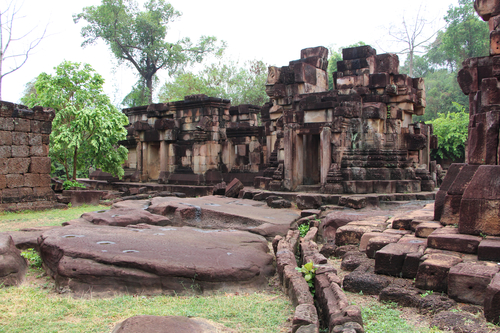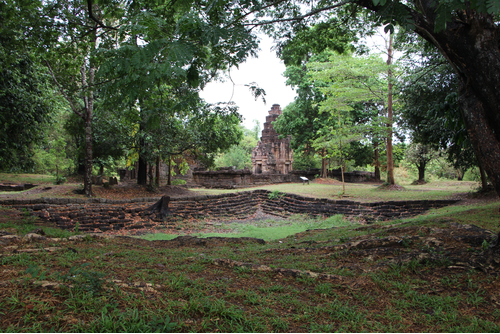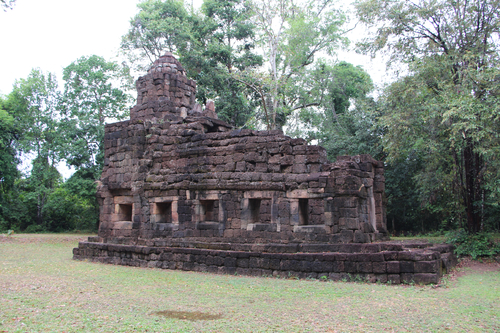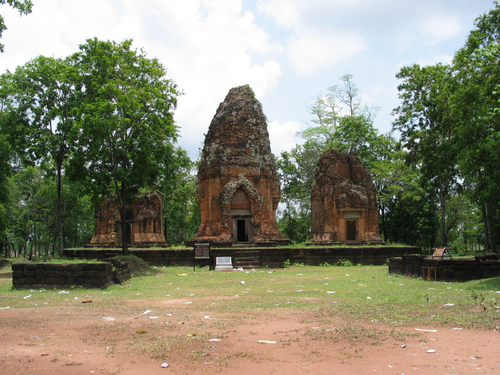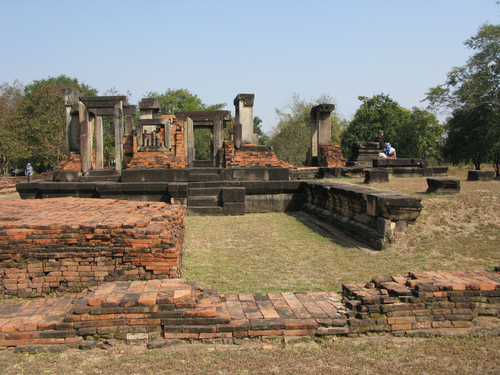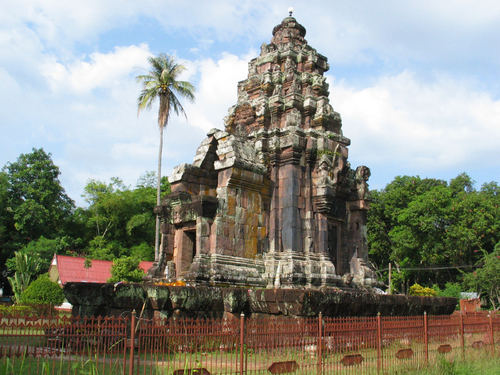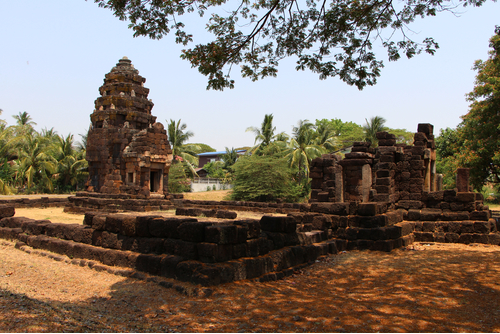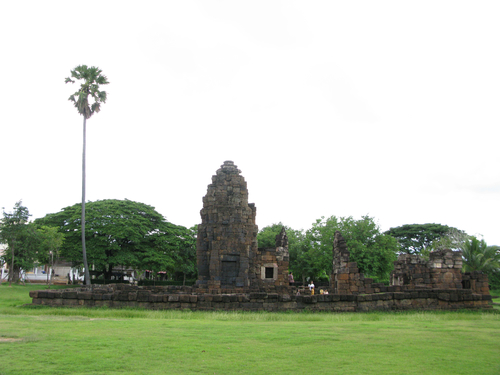ค้นหางานศิลปกรรม
ฐานข้อมูลศิลปกรรมในเอเชียตะวันออกเฉียงใต้
สถาปัตยกรรมปราสาทตาเมือนธม
ปราสาทตาเมือนธม เป็นปราสาทขนาดใหญ่ก่อสร้างด้วยหินทรายและศิลาแลง 3 องค์ ประกอบด้วยปราสาทประธานขนาดใหญ่ แผนผังรูปสี่เหลี่ยมจัตุรัสย่อมุม ภายในห้องกลางปราสาทประดิษฐานศิวลึงค์ ซึ่งเป็นสัญลักษณ์แทนพระศิวะ เทพเจ้าสูงสุดในศาสนาพราหมณ์ ลัทธิไศวนิกาย ลักษณะของศิวลึงค์นี้ตกแต่งจากแท่งหินทรายธรรมชาติที่มีรูปร่างคล้ายศิวลึงค์ที่ตั้งอยู่บริเวณนี้มาแต่เดิม ภายหลังจึงสร้างปราสาทครอบ สันนิษฐานว่านี้น่าจะเป็นศิวลึงค์ที่เกิดขึ้นเอง เรียกว่า “สวายัมภูลึงค์” ซึ่งเป็นศิวลึงค์ที่สำคัญที่สุดของลัทธิไศวนิกาย ตัวปราสาทมีซุ้มประตู 4 ทิศ ประตูมุขด้านทิศใต้ต่อเข้ากับมุขหน้าหรือมณฑปยื่นออกมา โดยแบ่งเป็น 3 คูหา หลังคาทำด้วยหินทราย ปราสาทประธานมีการสลักลวดลายที่บริเวณฐาน โดยสลักเป็นรูปเทวรูปยืน นอกจากนี้ยังพบทับหลังหินทรายสลักภาพเทวดานั่งชันเข่าอยู่ภายในซุ้มบนแท่นเหนือหน้ากาลที่คายท่อนพวงมาลัยปราสาทบริวาร หรือ ปรางค์น้อยมี 2 องค์ สร้างด้วยหินทราย ตั้งอยู่ด้านหลังเยื้องไปทางซ้ายและขวาของปราสาทประธาน แผนผังเป็นรูปสี่เหลี่ยมจัตุรัสย่อมุม มีซุ้มประตูเข้าออกอยู่ด้านทิศใต้ ส่วนอีก 3 ด้านทำเป็นประตูหลอกบรรณาลัย จำนวน 2 หลัง สร้างด้วยศิลาแลง หลังหนึ่งตั้งอยู่ด้านทิศตะวันออกเฉียงใต้ของปราสาทประธาน แผนผังเป็นรูปสี่เหลี่ยมผืนผ้า ส่วนอีกหลังหนึ่งตั้งอยู่ด้านทิศตะวันตกเฉียงใต้ของปราสาทประธาน แผนผังเป็นรูปสี่เหลี่ยมจัตุรัสปราสาทประธาน ปรางค์บริวาร และบรรณาลัย มีระเบียงคดล้อมรอบ ซุ้มประตูหรือโคปุระสร้างด้วยหินทราย มีแผนผังเป็นรูปสี่เหลี่ยมจัตุรัส มีช่องทางเดินภายในกว้างประมาณ 1.40 เมตร มีซุ้มประตูทั้ง 4 ด้าน โดยซุ้มประตูด้านทิศเหนือ ตะวันออก และตะวันตก มีลักษณะเหมือนกัน ส่วนซุ้มประตูด้านทิศใต้จะมีขนาดใหญ่ที่สุด เป็นซุ้มประตูหลัก โดยแบ่งออกเป็น 3 คูหา คูหากลางมีแผนผังเป็นรูปกากบาท มีหน้าต่างติดลูกกรงหินและบริเวณระเบียงคดนี้ได้พบศิลาจารึกอักษรขอมโบราณ ภาษาสันสกฤตและเขมร ซึ่งเป็นตัวอักษรที่ใช้ในราวปลายพุทธศตวรรษที่ 16 มีเนื้อหากล่าวสรรเสริญพระศิวะและกล่าวถึงนามของทาสและเจ้าหน้าที่ผู้ดูแลรักษาเทวสถานแห่งนี้ นอกจากนี้ยังพบท่าน้ำสร้างด้วยหินทรายนอกระเบียงคดด้านทิศใต้ ห่างออกไปประมาณ 10 เมตร และสระน้ำกรุด้วยศิลาแลงสอบลงไปถึงก้นสระ อยู่บริเวณนอกระเบียงคดทิศตะวันตกเฉียงเหนือ
สถาปัตยกรรมปราสาทตาเมือนโต๊ด
ปราสาทตาเมือนโต๊ด เป็นศาสนสถานพยาบาลเรียกว่า “อโรคยศาล” เพื่อให้เป็นสถานที่รักษาพยาบาลผู้เจ็บป่วย สร้างขึ้นในสมัยพระเจ้าชัยวรมันที่ 7 อายุราวพุทธศตวรรษที่ 18 องค์ประกอบทางสถาปัตยกรรมของอโรคยศาล จะมีลักษณะเหมือนกันทุกแห่ง คือ ปราสาทประธาน 1 หลัง สร้างด้วยศิลาแลงและหินทราย แผนผังเป็นรูปสี่เหลี่ยมจัตุรัสย่อมุม ส่วนยอดสลักด้วยหินทราย ลายกลีบบัว มีประตูทางเข้าออกด้านเดียว ส่วนอีก 3 ด้านทำเป็นประตูหลอก ประตูทางเข้าออกนี้ทำเป็นห้องยาวๆ ด้านหน้าเป็นมุข หลังคาทำจากหินทรายและศิลาแลง และด้านทิศตะวันออกเฉียงใต้ของปราสาทประธาน มีบรรณาลัยสร้างด้วยหินทรายและศิลาแลง แผนผังเป็นรูปสี่เหลี่ยมผืนผ้า มีประตูทางเข้าออก 1 ประตู ด้านทิศตะวันออก ทั้งหมดอยู่ในเขตกำแพงแก้วและซุ้มประตูสร้างด้วยศิลาแลง กำแพงแก้วมีแผนผังเป็นรูปสี่เหลี่ยมผืนผ้า มีซุ้มประตูอยู่ทางด้านทิศตะวันออก ซึ่งแบ่งออกเป็น 3 คูหา และบริเวณคูหากลางพบศิลาจารึก 1 หลัก ปัจจุบันอยู่ที่อาคารหอพระสมุดวชิรญาณ กรุงเทพมหานคร เป็นจารึกอักษรขอม ภาษาสันสกฤต สร้างขึ้นเมื่อประมาณพุทธศตวรรษที่ 18 สมัยพระเจ้าชัยวรมันที่ 7 ข้อความกล่าวถึง“พระไภษัชยครุไวฑูรยะ” หมายถึงพระโพธิสัตว์ผู้ประทานความไม่มีโรคแก่ประชาชนผู้นับถือ และกล่าวถึงเรื่องการสร้างอโรคยศาล หรือโรงพยาบาลให้เป็นสถานที่รักษาโรค โดยพระเจ้าชัยวรมันที่ 7 ทรงบริจาควัสดุอุปกรณ์พร้อมทั้งจัดเจ้าหน้าที่ให้อยู่ประจำสถานพยาบาลด้วย ส่วนด้านทิศตะวันออกเฉียงเหนือของปราสาท นอกกำแพงแก้วมีสระน้ำ 1 สระ
สถาปัตยกรรมปราสาทตาเมือน
รูปแบบแผนผังของปราสาทตาเมือน เป็นลักษณะของโบราณสถานที่เรียกว่า “ธรรมศาลา หรือ ที่พักคนเดินทาง” ซึ่งในสมัยพระเจ้าชัยวรมันที่ 7 ราวพุทธศตวรรษที่ 18 โปรดให้สร้างขึ้นตามเส้นทางที่สำคัญทั่วราชอาณาจักร ธรรมศาลานี้มีลักษณะเป็นปราสาทหลังเดียว ก่อสร้างด้วยศิลาแลงและหินทราย แผนผังเป็นรูปสี่เหลี่ยมจัตุรัสย่อมุม ด้านหน้าของปราสาททำเป็นห้องยาวสร้างด้วยศิลาแลง มีประตูเชื่อมต่อกับองค์ปราสาททางด้านทิศตะวันตก ห้องยาวนี้มีผนังด้านหนึ่งเจาะเป็นช่องหน้าต่างเรียงกันเป็นแถว ส่วนผนังอีกด้านหนึ่งทำเป็นหน้าต่างหลอก ด้านหน้าทางทิศตะวันออกมีประตูทางเข้าออก 1 ประตู มีทับหลังหินทรายสลักภาพพระพุทธรูปปางสมาธิในซุ้มเรือนแก้ว
สถาปัตยกรรมปราสาทกู่สวนแตง
ปราสาทกู่สวนแตง เป็นกลุ่มปราสาท 3 หลัง บนฐานเดียวกัน ส่วนฐานก่อด้วยศิลาแลง มีบันไดทางขึ้นบริเวณหน้าปราสาทองค์กลางเพียงแห่งเดียว องค์ปราสาททั้งสามหลังนี้ก่อด้วยอิฐ หันหน้าไปทางด้านทิศตะวันออก องค์ปราสาทเรียงตัวกันในแนวเหนือใต้ ขนาดของปราสาทองค์กลางมีขนาดใหญ่กว่าปราสาทที่ตั้งอยู่ขนาบข้าง ลักษณะแผนผังของปราสาทอยู่ในผังเพิ่มมุม โดยมุมประธานมีขนาดใหญ่ที่สุด ด้านทิศตะวันออกของปราสาท มีส่วนฐานของอาคาร 2 หลัง มีผังในรูปสี่เหลี่ยม สันนิษฐานว่าน่าจะเป็นบรรณาลัยสภาพในปัจจุบัน ได้รับการบูรณปฏิสังขรณ์แล้ว โดยปราสาทที่อยู่ตรงกลางมีสภาพสมบูรณ์ที่สุด ฐานด้านล่างเป็นฐานบัวลูกฟักก่อด้วยศิลาแลง 1 ฐาน ถัดขึ้นไปจึงเป็นองค์ปราสาทที่ก่อด้วยอิฐทั้งหลัง มีมุขยื่นออกไปทางทิศตะวันออก ปัจจุบันส่วนของมุขที่ยื่นออกมาพังทลายลงแล้ว เหลือเพียงกรอบประตูที่ทำจากหินทราย ส่วนยอดยังคงมีเค้าโครงให้เห็นถึงชั้นบนสุดแต่ไม่เหลือรายละเอียดให้เห็นมากนักส่วนปราสาทขนาบข้างส่วนยอดได้พังทลายลงมาจนเกือบหมดแล้ว ปราสาทองค์ทิศเหนือมีฐานด้านล่างเป็นฐานเตี้ยๆ ก่อด้วยศิลาแลง 1 ฐาน ถัดขึ้นไปจึงเป็นองค์ปราสาทที่ก่อด้วยอิฐทั้งหลัง มีประตูทางเข้าออกด้านทิศตะวันออก ส่วนชั้นหลังคาพังทลายลงบางส่วน แต่ไม่เหลือรายละเอียดให้ศึกษามากนัก ขณะที่ส่วนยอดของปราสาทองค์ทิศใต้พังทลายลงมากกว่า ในการกำหนดอายุ หากสังเกตุจากแผนผังของปราสาทแต่ละองค์มีแผนผังแบบเพิ่มมุม ซึ่งนิยมในช่วงราวพุทธศตวรรษที่ 16 เป็นต้นมา แต่จากการพบทับหลัง และการประดับนาคปักบนส่วนยอด จึงกำหนดอายุปราสาทหลังนี้ว่าน่าจะอยู่ในช่วงราวพุทธศตวรรษที่ 17
สถาปัตยกรรมปราสาทเมืองแขก
ปราสาทเมืองแขกมีขนาดค่อนข้างใหญ่ ก่อด้วยหินทรายและอิฐ แผนผังเป็นรูปสี่เหลี่ยมผืนผ้า หันหน้าไปทางทิศเหนือ สิ่งก่อสร้างสำคัญได้แก่ ปราสาทประธาน บรรณาลัย 2 หลัง ระเบียงคด ซุ้มประตูหรือโคปุระ กำแพงแก้ว สระน้ำ และปราสาทก่อด้วยอิฐขนาดเล็กลักษณะผังโบราณสถานแบ่งออกได้เป็น 3 ส่วน คือส่วนที่ 1 หรือส่วนในสุด ประกอบด้วยปราสาท 3 หลัง ก่อด้วยหินทรายและอิฐตั้งอยู่บนฐานเดียวกัน หัวหน้าไปทางทิศเหนือ เฉพาะองค์ปรางค์หรือปราสาทประธานมีมุขหรือมณฑปซึ่งมีลักษณะเป็นห้องต่อออกมาทางด้านหน้า มีบันไดขึ้นทั้งด้านหน้าและด้านข้างทั้ง 2 ข้าง พบฐานประติมากรรมหินทรายที่ครรภคฤหะของปราสาทประธานและปราสาทหลังด้านทิศตะวันออก อาคารทั้งสามหลังเหลือเพียงเฉพาะส่วนฐานและตัวอาคารบางส่วน รวมทั้งที่ปราสาทประธานยังคงหลงเหลือช่องหน้าต่างและลูกมะหวด เสาประดับกรอบประตู กรอบประตูหินทราย และทับหลังสลักภาพนารายณ์บรรทมสินธุ์ที่ด้านบนกรอบประตูหน้าสุดหรือส่วนมณฑปด้านข้างองค์ปรางค์ประธานมีฐานอาคารก่อด้วยอิฐ 2 หลัง อยู่ด้านซ้ายและขวาด้านละ 1 หลัง หันด้านหน้าเข้าสู่ปราสาทประธาน อาจเป็นวิหารหรือบรรณาลัย ในส่วนแรกนี้มีกำแพงแก้วก่อด้วยอิฐล้อมรอบ ทางด้านทิศตะวันออกของกำแพงมีอาคารอิฐผังสี่เหลี่ยมผืนผ้าก่อขนานยาวไปกับกำแพง อาคารหลังนี้มีประตูเข้าออกอยู่ด้านทิศตะวันตกและทิศเหนือ ยังคงหลงเหลือเสาประดับกรอบประตูอยู่ที่ประตูด้านทิศเหนือมีซุ้มประตูทางเข้าหรือโคปุระชั้นในอยู่ด้านเดียวคือด้านหน้าหรือด้านทิศเหนือ (มีช่องประตู 3 ช่อง) ที่ยังคงหลงเหลือกรอบประตูและเสาประดับกรอบประตูหินทราย นอกจากนี้ยังปรากฏฐานอาคารก่อด้วยอิฐอีก 2 หลังที่มุมกำแพงแก้วด้านหน้าของปราสาทประธาน ข้างโคปุระหรือซุ้มประตูชั้นในด้านหน้าหรือด้านทิศเหนือทั้ง 2 ด้าน ซ้ายและขวา โดยอาคารด้านขวามีทางเดินปูอิฐเชื่อมกับอาคารยาวที่ขนานไปกับกำแพงแก้วด้านทิศตะวันออกส่วนที่ 2 เป็นกำแพงชั้นนอก ซึ่งขุดเป็นสระเกือบจะล้อมรอบโบราณสถาน เว้นเพียงส่วนกลางด้านหน้า โดยใช้ดินที่ได้จากการขุดสระทำเป็นคันกำแพงล้อมรอบกำแพงแก้วและสระน้ำ ทางด้านทิศเหนือมีทางเดินเชื่อมกับส่วนในหรือส่วนที่หนึ่ง กำแพงชั้นนอกด้านหน้าหรือด้านทิศเหนือมีซุ้มประตูขนาดใหญ่หรือโคปุระชั้นนอกรูปกากบาท ตรงกับโคปุระชั้นใน (มีช่องประตู 3 ช่อง) ยังคงปรากฏช่องหน้าต่างและลูกมะหวดรวมทั้งกรอบประตูหินทรายส่วนที่ 3 อยู่นอกกำแพงชั้นนอกหรือส่วนที่สองออกมาทางด้านหน้าหรือด้านทิศเหนือ มีฐานอาคารก่อด้วยฐานก่อด้วยศิลาแลง หินทราย และอิฐ 2 หลัง ด้านซ้ายและขวาด้านละ 1 หลัง หันหน้าเข้าหากัน (อาคารหลังด้านขวาหันหน้าไปทางทิศตะวันตก ส่วนอาคารหลังด้านซ้ายหันหน้าไปทางทิศตะวันออก) ส่วนบนอาจจะสร้างด้วยไม้ ฐานอาคารทั้งสองหลังมีผังเป็นสี่เหลี่ยมมีมุขยื่นมาทางด้านหน้า ฐานสูง มีบันไดขึ้นสู่ด้านบนของฐานทั้ง 4 ด้าน มีกำแพงล้อมรอบ มีโคปุระที่ด้านหน้าและหลัง (ด้านหน้ามีขนาดใหญ่กว่า) ภายในห้องประธานของอาคารหลังด้านทิศตะวันตกมีฐานศิวลึงค์และโยนีหินทรายตั้งอยู่กลางห้อง เช่นเดียวกับอาคารหลังด้านทิศตะวันออกที่มีฐานประติมากรรมหินทรายตั้งอยู่กลางห้องประธาน จากการขุดค้นที่พบหลักฐานสำคัญ เช่น ศิวลึงค์ ฐานศิวลึงค์ หน้าบันสลักภาพอุมามเหศวร ทับหลังภาพพระอินทร์ทรงช้างเอราวัณ ทับหลังรูปพระนารายณ์บรรทมสินธุ์ ทับหลังรูปเทวดาประทับนั่งในซุ้มเหนือหน้ากาล ประติมากรรมโคนนทิ และจารึก 3 หลัก ทำให้สันนิษฐานได้ว่าศาสนสถานหลังนี้สร้างขึ้นเนื่องในศาสนาพราหมณ์ไศวนิกาย อายุราวปลายพุทธศตวรรษที่ 15 ถึงต้นพุทธศตวรรษที่ 16 ในศิลปะร่วมแบบเกาะแกร์-แปรรูป ส่วนจารึกระบุมหาศักราช 896 ตรงกับ พ.ศ.1517
สถาปัตยกรรมปราสาทนารายณ์เจงเวง
ปราสาทนารายณ์เจงเวง เป็นปราสาทหลังเดี่ยว ก่อด้วยหินทราย ทั้งหลัง ซึ่งถือเป็นลักษณะพิเศษ เนื่องจากปราสาทในภาคตะวันออกเฉียงเหนือตอนบนหลังอื่นๆมักใช้วัสดุอื่นหรือวัสดุผสม ถ้าอนุมานจากรายละเอียดของภาพสลักและการใช้วัสดุ ย่อมแสดงใหเห็นว่าปราสาทแห่งนี้มีความพิเศษที่แตกต่างไปจากปราสาทในบริเวณเดียวกัน เช่น ปราสาทพระธาตุดุม และปราสาทภายในพระธาตุเชิงชุมแผนผังปราสาทประกอบด้วยห้องครรภคฤหะและมีมุขยื่นออกมาทางด้านทิศตะวันออก มีประตูทางด้านหน้าเพียงทิศเดียว ส่วนทิศอื่นเป็นประตูหลอก ซื่งปรากฏโดยปกติกับปราสาทในศิลปะบาปวนและนครวัดในภาคตะวันออกเฉียงเหนือของประเทศไทย สิ่งที่น่าสนใจสำหรับปราสาทแห่งนี้ก็คือยังคงปรากฏโสมสูตรที่ประตูหลอกทางด้านทิศเหนือ ภาพสลักส่วนมากเป็นภาพเล่าเรื่องในไวษณพนิกาย เช่น นารายณ์บรรทมสินธุ์ พระกฤษณะปราบสิงห์ เป็นต้น อย่างไรก็ตาม หน้าบันกลางกลับแสดงภาพศิวนาฏราชซึ่งอาจแสดงให้เห็นว่าปราสาทแห่งนี้สร้างเพื่ออุทิศให้กับไศวนิกายมากกว่า
สถาปัตยกรรมปราสาทหนองบัวราย
ประกอบด้วยปราสาทประธานมีทางเข้าหันหน้าไปทางทิศตะวันออก ทางเข้านั้นทำเป็นมุขยื่นออกมาและมีการเจาะช่องหน้าต่างทั้ง 2 ด้านๆ ละ 1 ช่อง ยอดปราสาทมี 4 ชั้น มีการเจาะตกแต่งเป็นช่องสี่เหลี่ยม ด้านทิศตะวันออกเฉียงเหนือมีบรรณาลัยตั้งหันหน้าเข้าปราสาทประธาน ด้านหน้าของปราสาทประธานมีทางเดินรูปกากบาททอดยาวมาจนถึงโคปุระ ทั้งหมดนี้ล้อมรอบด้วยกำแพงแก้วในบริเวณใกล้เคียงพบชิ้นส่วนหน้าบันรูปพระวรกายพระโพธิสัตว์อวโลกิเตศวร 4 กร ประทับยืนตรง ด้านทิศตะวันออกเฉียงเหนือนอกแนวกำแพงแก้วมีสระน้ำในผังรูปสี่เหลี่ยม จากลักษณะของแผนผังและรูปแบบการก่อสร้าง เช่น ตัวปราสาทที่มีมุขยื่นและมีช่องหน้าต่างทั้ง 2 ด้าน จะพบโบราณสถานในรูปแบบเดียวกันได้อีกที่กู่สันตรัตน์ จังหวัดมหาสารคาม หรือปราสาทตาเมือนโต๊ด จังหวัดสุรินทร์ เป็นต้น
สถาปัตยกรรมปรางค์กู่
ปรางค์กู่เป็นโบราณสถานอีกแห่งหนึ่งที่มีแผนผังและลักษณะเหมือนกับโบราณสถานที่ได้พบหลักฐานว่าเป็นอโรคยาศาล ที่สร้างขึ้นในพุทธศตวรรษที่ 18 ก็คือ มีองค์ประธานอยู่ตรงกลาง 1 องค์ บรรณาลัยด้านหน้า 1 หลัง ล้อมด้วยกำแพงซึ่งมีโคปุระเฉพาะด้านหน้าทั้งหมด ก่อด้วยอิฐศิลาแลงยกเว้นกรอบประตูหน้าต่าง ทับหลัง เสาประดับล้วนเป็นหินทราย หันหน้าไปทางทิศตะวันออก ทิศตะวันออกเฉียงเหนือของปรางค์มีสระน้ำ 1 สระ ยังคงสภาพสมบูรณ์ โดยเฉพาะองค์ประธานซึ่งมีผังเป็นรูปสี่เหลี่ยมจัตุรัสขนาด 5 เมตร ย่อมุมไม้สิบสอง ด้านหน้ามีประตูทำเป็นมุขยื่นออกมา ผนังปรางค์อีก 3 ด้านเป็นประตูหลอก จำหลักภาพตรงกลางเป็นพระพุทธรูปประทับนั่งปางสมาธิ ซึ่งจับท่อนพวงมาลัยไว้ด้วยมือทั้งสองข้าง ด้านข้างทางซ้ายและขวาจำหลักรูปพระโพธิสัตว์อวโลกิเตศวร 4 กร กับรูปนางปรัชญาปารมิตา ด้านหน้ามีทับหลังเช่นกัน สันนิษฐานว่าสลักเป็นภาพเดียวกัน แต่ปัจจุบันลบเลือนมาก ที่ช่องประตูหลอกด้านทิศเหนือยังมีพระพุทธรูปศิลาปางสมาธิ ศิลปะแบบทวาราวดี ขนาดสูง 1.75 เมตร หน้าตักกว้าง 7.5 เมตร ประดิษฐานอยู่ 1 องค์ ซึ่งเป็นของที่เคลื่อนย้ายมาจากที่อื่น
